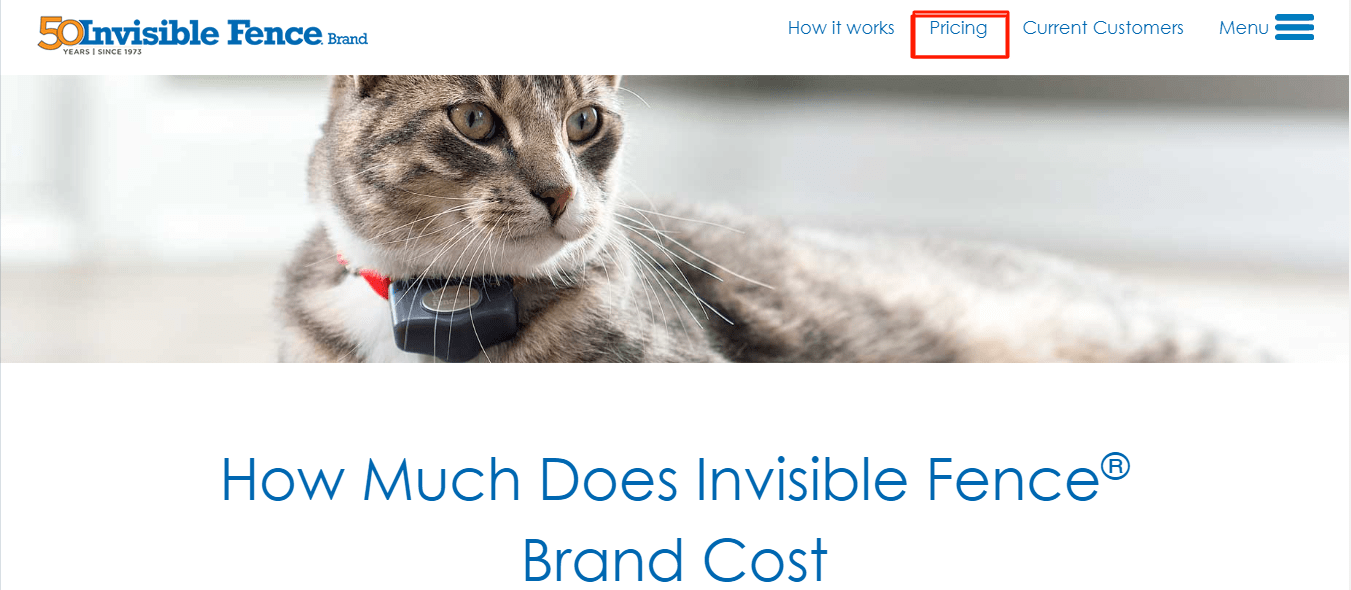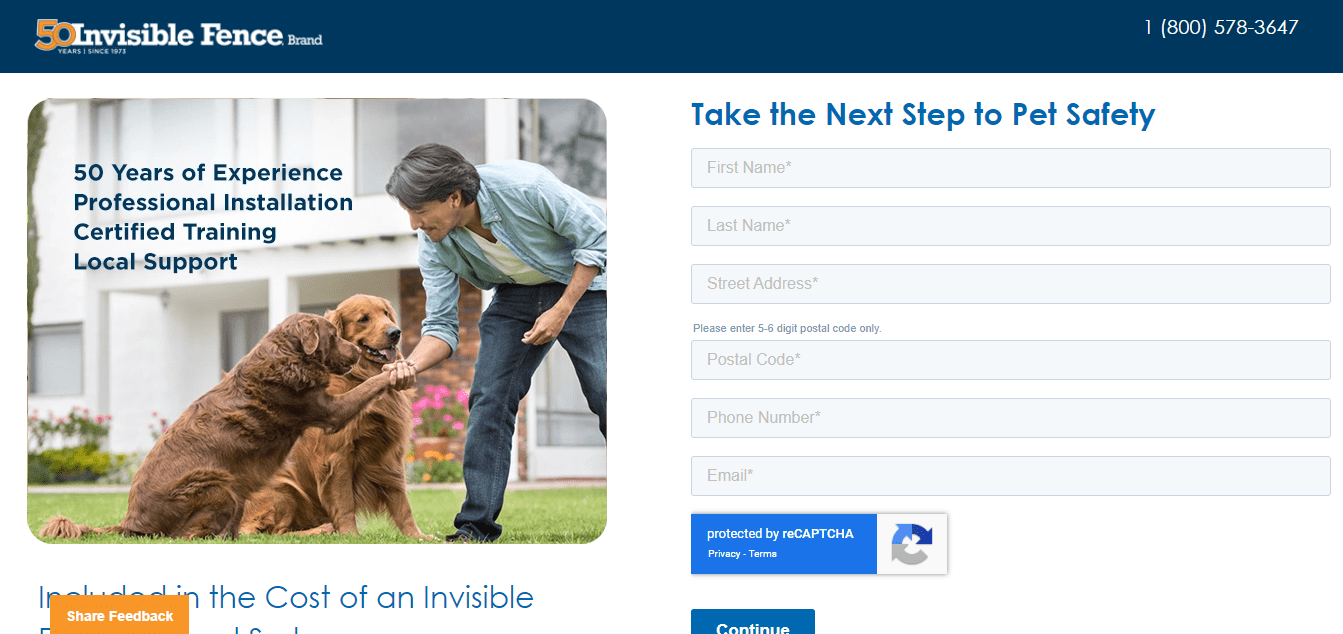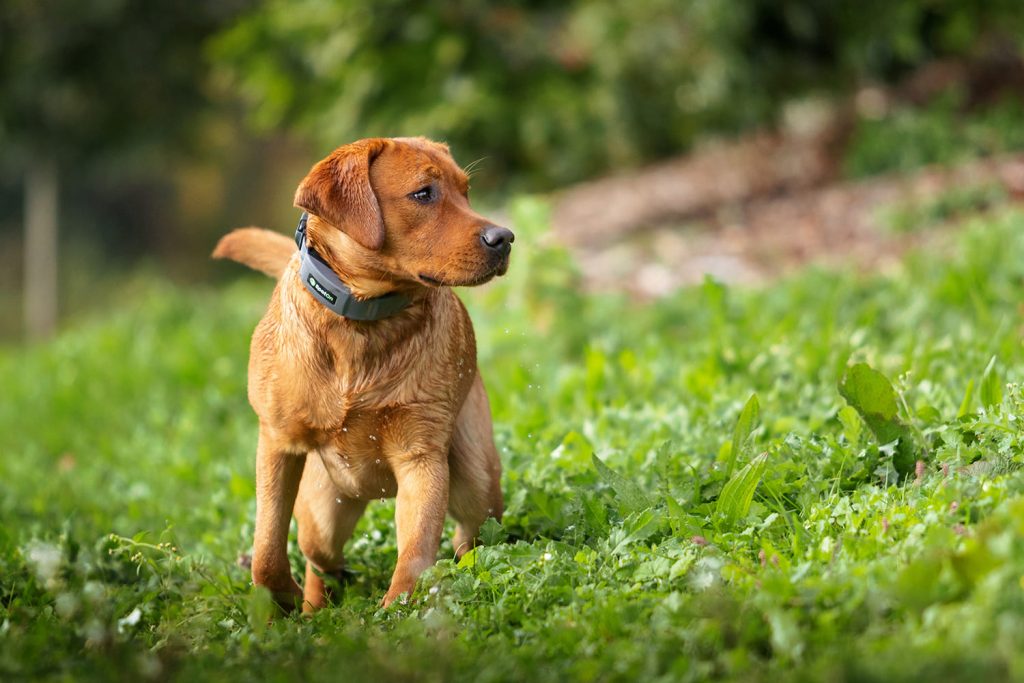This post contains affiliate links, we'll earn compensation if you make a purchase using them at no additional cost to you 😊
Usually, when installing an invisible fence, many people are unsure whether to do it themselves or hire a professional.
However, with invisible fence tool kits available in the market, it is easier to do it all by yourself without professional help.
Hence, we have curated a step-by-step guide For How To Install An Invisible Fence.
Right from planning out the fenced area in your yard to getting your dog to train to stay within the fence, we have covered all the information that you need.
So, to understand this guide in-depth, let’s delve right into the details.
Overview
Underground dog fences require some effort to set up, but once they are, you won’t need to use regular fences to contain your dog and need not be concerned about your dog fleeing once they are in place.
How Do Electronic Fences Work?
By using a little electricity for the dog inside the yard, electronic pet containment, which is also known as an electric dog fence, is a method of dog training.
A transmitter for the invisible dog fence plugs into a regular outlet and sends out a signal that travels through underground lines. A receiver attached to your dog’s collar establishes a hidden border, and when the dog approaches the boundary, the receiver sounds an alert.
By doing this, no one will have any idea about where the boundaries are, but your dog will definitely know what his limits are.
This system can be used to create boundaries where your dog cannot jump over or even dig holes under the wiring. These fences are sometimes used to keep dogs away from flower beds and swimming pool areas, as dogs can wreck them by playing in them.
While using this device, remember that the shock release from the receiver is stronger than the normal shock released by a static electric force.
These invisible fences are designed to get your dog’s attention the moment you want your dog to listen to your commands while making sure that it won’t cause any harm to your dog.
Once you train your dog properly to understand the whole idea of invisible fences, your dog will learn to listen to the audio signal with a beep or other sound and won’t have to face the shock of crossing the boundary.
How To Installing Invisible Fence? (Step-By-Step Guide)
Here is the step-by-step guide for How To Install An Invisible Fence:
Step #1: Plan The Precise Boundaries Of Where You Want Your Dog To Stop
Thanks to this procedure, you’ll be able to purchase the precise quantity of wire. To mark the area where the wire will eventually be buried, plant some flags as markers all around the yard.

In contrast to over-ground fences, which are typically required to be placed in a straight line, underground dog fences make it possible to design around elliptical yard features.
In addition to preventing your dog from wandering, underground dog fences can also keep your dog out of places you do not want the dog to be.
For example, you may wrap the wire around a swimming pool or a flower garden.
Step #2: The Space You Want To Restrict The Dog Should Be Measured In Both Length And Width
Measure the size of the area where you intend to install the dog fence using a long measuring tape.
Since the dog will be unable to get through the walls of your house, you are not required to measure it.

All you need to know is how lengthy the wire needs to be to completely enclose the space you wish to keep your dog in.
By doing this, you may get the correct length of wire and ensure that you don’t spend more money on it than you have to.
Step #3: Purchase The Necessary Tools, Such As A Transmitter, A Shock Collar, And Wires
The majority of underground dog fence kits include wire and a transmitter and, depending on their strength, can cover up to 500 acres.

Make sure the kit includes enough wire to enclose the space you wish to keep your dog within.
Step #4: Locate A Suitable Location To Fix The Transmitter
The transmitter should not be placed closer to any devices, switches, or other potential electrical interference producers.

Generally, putting it in a basement or garage is a good idea, but ensure that you keep it aside from any objects that can interfere with the system.
According to the instructions in your transmitter user guide, grounding the transmitter will shield it from external electrical interference. Also, it will help prevent serious damage.
Use a lightning suppressor to ensure the fence is maintained amid electrical interference. Also, for your dog’s safety, bring your dog inside if the electricity goes off until the buried fence is activated.
Step #5: Using The Flags You Marked In The First Step, Lay The Wire Underneath Them
Make sure you have sufficient wire to get back to the beginning point before laying the wire in a straight manner through the confines of the space.
Also, round them off if there are any 90-degree angles because certain transmitters won’t detect the sudden curve.
The wire should not be twisted as much as possible because doing so could interfere with the transmission and make the wire ineffective along your boundaries.
Step #6: To Test The System, Link The Transmitter With The Wire Together
To test the system, you don’t have to bury the wire. Just connect the transmitter’s wire at both ends and turn it on.
After connecting the receiver to the collar, step over the wire a few times. When the collar is getting close to the border, you should hear a ” beep.”
Even though it might seem simple, you shouldn’t test the collar while wearing it or come in contact with the metal to get a jolt.
It should emit a signal to let you confirm it is working properly. The shock is moderate yet painful.
Step #7: Using The Flags As A Guide, Establish A Trench
Create a narrow trench just below the yard’s ground using a scoop or gardening fork so that the wire may be laid in it.
Keep the flags in place so that your dog may learn the location of the yard’s limits.
Don’t dig too deeply because if you do, the transmitter won’t be able to pick up indications from the wire whenever your dog crosses the boundary.
The wire can be laid on top of the grass to get the same result, but it is advised to place it just below the surface to avoid stumbling over it or unintentionally slashing it with a lawnmower.
Step #8: Place The Wires In The Trench, Cover Them With Soil, And Retest The System
Make sure you completely bury the wire in the dirt you previously dug as you round the garden.
Keep all wires underground; otherwise, you run the risk of tripping over them or accidentally cutting them when mowing the grass.
Prepare to teach your dog and test the system once more in several areas to ensure it works as intended.
If you don’t choose to bury the wire, make an effort to conceal it and tuck it as deeply into the ground as you can.
Step #9: Here, You Are Ready To Train Your Dog With The Invisible Collar
In this step, you will be free to train your dog with the help of an invisible collar. You can train your dog with the necessary tools needed for the training.
Also, you can learn how to train your dog using an invisible fence or a training collar from one of our guides to get started on this journey with your furball.
How To Install A Wireless Invisible Fence?
A wireless dog fence is the safest option and a perfect solution to keep your dog contained in your yard while avoiding the hustle of digging around the ground.
Here’s a simple yet comprehensive guide:
Step #1: Choose the Right Unit:
Always choose a wireless dog fence that perfectly fits your dog’s neck size and also covers the yard.
Step #2: Find a Spot for the Transmitter:
Put the transmitter device on the ground floor of your house by finding the nearest power outlet where it won’t freeze. Place it far from big metal objects like fridges.
Step #3: Setting Up the Transmitter:
Plug the transmitter device in. Turn up the boundary switch high and set the boundary control to 8.
Step #4: Prepare the Collar:
Insert the battery. You can choose to activate the static correction, which uses a little shock to keep your dog inside.
Step #5: Mark the Boundaries:
Wherever you want your dog to stay, hold the collar. As soon as the dial beeps, have someone turn it. Flag the areas where it beeps.
Step #6: Equip Your Dog with a Collar:
A collar should come into contact with your dog’s skin. Make adjustments so that your dog’s collar and neck can fit through one finger.
Step #7: Train Your Dog:
Use the flags to show where your dog can’t go. Let your dog explore, and the collar will beep or shock when they get too close to the boundary. Keep doing this until your dog knows.
Train Your Dog For Invisible Fence
A proper training course should be given to your dog to get used to the invisible fence. Training your dog takes about two weeks before you rely on the invisible fence to leave it alone in the yard. Hence, let’s see how you can train your dog as per the need:

Step 1: In the first step, put the collar on your dog and turn it on in beep mode only while keeping your dog on a leash. Start walking around in the yard with your dog, and whenever you go near the boundary, bring the dog back to the center when you hear the beep sound.
Give your dog lots of treats and rewards to make the dog feel that he did something wrong. Keep repeating this step until your dog understands the meaning behind your actions.
Step 2: In this step, change the stimulation setting from beep to vibration or shock and keep the sensation level at the lowest. Again, start moving around with your dog in the yard.
Whenever your dog goes near the boundary, the collar will release the stimulation, and then you bring the dog back to the center. Repeat the same process multiple times.
Moreover, ensure the collar is placed correctly and touching your dog’s skin. You can increase and decrease the shock levels as per the need.
Step 3: In the last step, all you have to do is see how your dog is reacting to all the distractions in the yard. However, at this point, your dog needs to be on a leash, too.
To perform this step, roll over a ball and make it cross the boundary. If your dog learns from the training and doesn’t cross the boundary, it means he has been trained to stay within the boundary.
How Deep Does An Invisible Fence Need To Be Buried?
The majority of systems advise burying the cables between one and three inches below ground.
Although the wires don’t have to be buried to function, it’s simple to trip over them or cut them with a lawnmower or trimmer if they are above ground. Inspect your cables above ground prior to their burial.
Benefits Of An Invisible Dog Fence
Here are a few benefits that make installing an invisible dog fence worth spending money and time on:
1. Affordable Price
While less costly variations of conventional fences are available, neighborhood laws frequently restrict building materials. Certain fencing materials, like wood and iron, can be costly, and labor costs extra. Even with competent installation, invisible electric fences are frequently less expensive.
2. Flexibility
Invisible fencing can be installed on nearly any surface, although regular fences perform best in yards that are level or moderately slope. Installing invisible walls over rivers, forests, and hills is possible. Electronic fences can also be used to construct expansive dog exercise facilities by covering acres of land in any layout.
3. Aesthetics
Well, invisible fences are just that—invisible. These barriers improve the sense of being outside without overtly interfering with picturesque views or green areas. Without having to deal with the inconvenience of opening and closing gates, people are free to walk around the yard. The temporary discomfort that comes with outlining flags. The flags can be taken down once the dog is familiar with the electric fence’s bounds.
4. Easy Access
Comparatively speaking, electric fences can be installed faster than traditional enclosures. It takes less time to trench and lay wire than it does to lay welding iron, rolling wire, fence posts, or nail boards.
5. Dependability
An electric fence might be a better way to keep dogs contained if they have a propensity to chew through, burrow under, or climb over fences.
Reduced Error by Humans. Electric fences lessen the possibility of escape in hectic homes with plenty of foot traffic because pet owners frequently forget to close gates.
6. Defense
Because they are unlikely to realize that the dog might not be able to reach them, having a dog in the garden may prevent intruders.
What Are The Negatives Of An Invisible Fence?
Here are a few negative factors you should consider before installing an invisible fence:
1. Training Is Required
The dog needs to learn where the fence is in order for it to succeed. This calls for a period of training during which the dog and owner travel the fence’s perimeter while noting the flags. Typically, fencing firms work with owners and their dogs for a certain amount of time and offer training regimens.
2. Absence Of Defense
Invisible fences protect dogs since they can’t escape the yard, but risks can still enter the yard. Wild animals and stray dogs are still able to enter the yard and engage in violent behavior with pet canines.
3. Annoyance With Barriers
Some dogs get angry when they see other dogs in the neighborhood play freely and realize they are not allowed to join in. This is particularly annoying if nearby dogs play close by or engage in “teasing.” Canines that are outgoing and gregarious also get irritated when they see another dog or person coming but are unable to say hello.
4. Level Of Unease
Dogs swiftly learn to obey the “beep” in order to avoid shock because most electric fences have an audio warning system before the electric impulse. If the device is configured correctly, an electric stimulation that startles the dog but is not painful is released when it ignores the audio signal.
Related read;
Conclusion: How To Install An Invisible Fence?
Invisible fences can be incredibly beneficial in keeping your dog near to home with appropriate installation and continuous training.
These devices are affordable and easy to install. They may also work well for lots with unusual shapes or uneven terrain.
Installing an invisible fence may be your only alternative if local laws prevent you from constructing a physical fence for you and your pet.
Following the instructions in this post, I hope you can confidently build an invisible dog fence and establish boundaries for your pet.
FAQs
Invisible dog fences were previously exclusively available for professional installation.
Still, nowadays, do-it-yourself installation is so simple that just about anyone who can use a spade and a screwdriver can complete the task.
The answer is that an electric fence IS NOT REQUIRED to complete a full loop.
For underground installation, it can be installed up to 12 inches or be affixed above ground with yard staples.
You should always use insulated wire that is rated for burial. Ideally, polyethylene or plastic coated, regardless of gauge.


